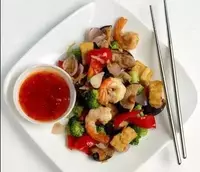The chinese

In China, eating is considered not just a quenching of hunger, but a sacred ritual. And culinary experts even have certain laws that they strictly follow when preparing food.
Law One. Before starting to prepare a dish of Chinese cuisine, the cook must carefully process all the products. Sometimes it takes a third of all the time spent cooking. For example, if a chicken is cooked, it is never scorched, and the feather behind the feather is plucked with special tweezers. As for vegetables and fruits, they should be repeatedly washed with water.
Law Two. Very fast heat treatment of products, which should not exceed four minutes. To do this, culinary experts use a strong fire, as well as a variety of dishes that speed up the cooking process: pressure cookers or a wok pan.
Law Three. Chinese cuisine is simply unthinkable without the addition of all sorts of sauces, spices and spices, of which there are more than 300 species.
Law Four. Adherence to the composition when composing a dish according to taste, color and smell. It's no easy task, so picking ingredients so they fit perfectly together is a whole culinary art that's not available to every chef.
All this is taken together and makes up the uniqueness of Chinese cuisine, which is distinguished by unusual ways of cooking with the addition of a large amount of spices, aesthetic design of dishes with the right combination of components. No other country can boast such a perfect art of cooking as China.
Today in China, the most popular type of meat is pork, with meat usually cut into small pieces (straws or cubes) and fried over high heat. In addition, poultry meat, especially ducks and chickens, is often used. They are prepared and served with a variety of sauces, seasonings, starch and spices.
Chicken and duck eggs are also in high demand and act as important ingredients in recipes for Chinese cuisine. Most often they are used in cold and hot snacks, and are also preserved in a special way, the essence of which is as follows: eggs are coated with a special mixture and placed in vats or earth for a long time (up to a hundred days). As a result, the egg white turns brown and the yolk turns green. Unusual for us, but the Chinese just adore them.
In addition to meat and eggs, fish and other seafood occupy an important role in Chinese cuisine, among which the most popular are Chinese bass and flounder, as well as marine invertebrates: shrimp, crabs and many mollusks.
They love the Chinese and all kinds of flour products, which here are represented by noodles, vermicelli, various tortillas, steam loaves (pampushki), wontons, ears and sweet cookies.
Vegetables play a huge role in the diet of the indigenous population, which are included in numerous recipes of Chinese cuisine: various types of cabbage, potatoes, sweet potato, radish of various varieties, garlic, green onion-batun, pepper, tomatoes, spinach and green green beans. Thick young bamboo shoots in boiled form are especially popular in China.
Of the drinks, the Chinese prefer green tea, which is customary to brew in porcelain teapots, and drink very hot and without sugar. Given the universal Chinese love of green tea, it's no surprise that the traditional meal here starts and ends with a tea party.
 Español
Español Français
Français Português
Português Русский
Русский 简体中文
简体中文 繁體中文
繁體中文 日本語
日本語 한국어
한국어 العربية
العربية Türkçe
Türkçe Қазақ
Қазақ Deutsch
Deutsch Italiano
Italiano Українська
Українська
